nimgoldman
Hazard to Others
  
Posts: 303
Registered: 11-6-2018
Member Is Offline
|
|
Silver nitrate producing chlorine smell and yellowing plastic
I left my freshly made silver nitrate crystals in a vacuum desiccator for three weeks away from light (I wrapped the entire desiccator in an aluminium
foil and stored it in a closet). When I returned from holidays, I was suprised that the AgNO3 crystals hardened into leafs and the
desiccator plastic completely yellowed:
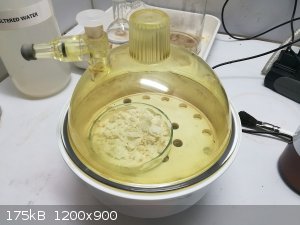
Both the polycarbonate cover and polypropylene insides were affected. Here is the inside part with drying agent (calcium chloride) which seems to have
taken up only very little water as it still powdery:
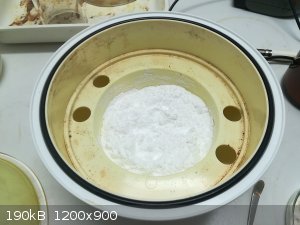
The vacuum was already broken by the time I opened the desiccator, but the lid was still sitting nicely and snuggly on the bottom part so I don't
think this was caused by a chemical or some leaking inside. The drying agent used was also taken fresh from the bottle.
When I opened the desiccator, it smelled just like entering a swimming pool - a faint chlorine smell.
I have no idea where this came from. Originally, I made this silver nitrate from silver chloride using the "sugar and lye method" in the following
way:
I washed the mixture crude AgCl (inevitably contaminated with some silver oxide, due to light exposure) several times with hot water. After the
washings, I added conc. NaOH solution to the water/AgCl suspension while stirring, until add the solids turned to the brown-black silver oxide
(Ag2O). After that, I added small portions of reducing sugar (dextrose, purchased as food grade glucose powder) until all the silver turned
into metal form (black oxide to gray metal).
Finally, I washed the solution many times with water, filtering and washing the silver on filter. Unfortunately, the water was still orange-brown even
after 8 washings (not sure why - residual silver oxide?).
I then dissolved the silver powder in minimal amount of hot 68% nitric acid and left it to crystallize. Here is the crude silver nitrate (I assume the
brown color comes from the oxidised sugar):
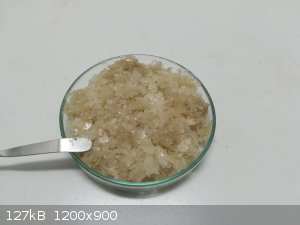
I have recrystallized this from distilled water, getting much purer product:
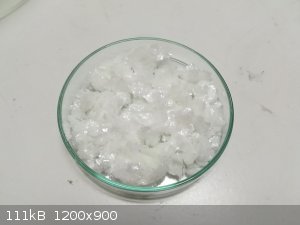
I placed this in a vacuum desiccator over CaCl2 and pulled about 100 mbar vacuum.
After 3 weeks, this is how the crystals ended up, along with yellowing the whole desiccator:
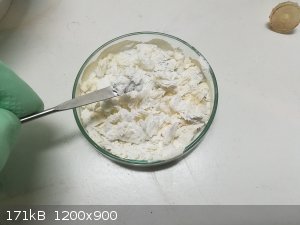
I have absolutely no idea what went wrong, but I already encountered this issue once when slowly evaporating supernatant water from first crop of
AgNO3 crystals. The second crop of AgNO3 plates growing from the water were nice and transparent, but the dish smelled exacly
like hydrogen chloride, including the biting sensation in the nose.
I recycle silver from various other compounds (mostly silver halides and silver nitrite) by converting it all into silver chloride followed by the
above procedure.
I have no idea where all the chlorine comes from since all Cl- ions should have been washed from the silver metal as NaCl (produced by
sodium hydroxide treatment).
However, it there was any AgCl present, it would of course produce chlorine gas.
If this is the case, I think more purification is necessary, maybe flaming the silver powder in a crucible, breaking down any halide residues.
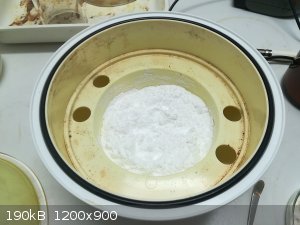
|
|
|
Sulaiman
International Hazard
    
Posts: 3558
Registered: 8-2-2015
Location: 3rd rock from the sun
Member Is Online
|
|
I think that due to its extreme solubility and its tendencey to super-saturate,
silver nitrate is best crystalised slowly by evaporation.
Crystalisation by cooling tends to cause a lot of irregular crystals to crash out rapidly,
trapping/entraining/including supernatant liquid and its impurities.
CAUTION : Hobby Chemist, not Professional or even Amateur
|
|
|
nimgoldman
Hazard to Others
  
Posts: 303
Registered: 11-6-2018
Member Is Offline
|
|
Yes I observed the supersaturation - even when leaving the beaker to cool down on its own, the solution tends to flash-crystallize at one point if
agitated or stay superstaturated until agitated. It seems slow evaporation is the only option to grow relatively uncontaminated crystals.
I was just surprised by the amount of gas (probably chlorine) generated from recrystallized material. Especially after filtering the solution prior to
crystallization (silver chloride should have been captured and its solubility is extremely low anyway - it should not be there excepd if trapped in
crystals forming too quickly).
|
|
|
ninhydric1
Hazard to Others
  
Posts: 345
Registered: 21-4-2017
Location: Western US
Member Is Offline
Mood: Bleached
|
|
NOx and Cl2, from my experience, have similar odors when in small concentrations. Maybe it's the AgNO3 minorly decomposing?
The philosophy of one century is the common sense of the next.
|
|
|
nimgoldman
Hazard to Others
  
Posts: 303
Registered: 11-6-2018
Member Is Offline
|
|
Quote: Originally posted by ninhydric1  | | NOx and Cl2, from my experience, have similar odors when in small concentrations. Maybe it's the AgNO3 minorly decomposing? |
Yes it might be the case.
Could AgNO3 decompose in the desiccator to the extent of completely yellowing the plastic? I know NO2 is acidic but never expected it being so
aggressive.
It would mean a glass desiccator is a must for drying such a compound or leaving it there for shorter time. Well I once dried pyridine hydrochloride
and the desiccator smelled of pyridine for several months even after washing it twice... the plastic desiccator is like a sponge for chemicals.
|
|
|
chemister2015
Harmless

Posts: 28
Registered: 25-2-2015
Location: Russia, Khabarovsk
Member Is Offline
Mood: No Mood
|
|
I think this is photodissociation.
2AgCl --hv--> 2Ag + Cl2
2AgNO3 --hv--> 2Ag + 2NO2 + O2
|
|
|